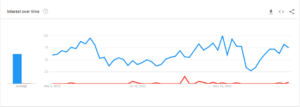NOTE: This is our 2nd post in a series on #observability. You can find the 1st post here.
Monitoring your systems has become commonplace for SMBs. Monitoring involves regularly checking and tracking the performance and behavior of a system or application to identify any issues or potential problems. It typically involves collecting and analyzing data about key performance metrics (KPIs), such as response times, error rates, and resource usage, to ensure that the system is operating as expected.
Observability (O11y) refers to the ability to gain insights into the behavior of a system or application from the outside by collecting and analyzing data about its internal state and interactions. It involves providing visibility into the internal workings of a system or application and allowing for the efficient identification and resolution of issues that may arise.
The Google Trends chart below extenuates the need to educate SMBs on the need and benefit of observability.
Reread those last two paragraphs. Observability and monitoring are closely related but not the same thing. Monitoring is the process of collecting data and information about a system to understand its behavior and identify any problems that may be occurring. On the other hand, Observability is the degree to which the internal state of a system can be inferred from its external outputs.
In other words, monitoring involves collecting data and information about a system, while observability is using that data to understand and infer what is happening inside the system. Monitoring is an essential part of observability but not the only aspect. Observability also includes analyzing and interpreting the data collected through monitoring to understand how a system is functioning and identify any issues that may be present.
Observability is essential in various contexts, including engineering, computer science, and other fields, because it allows people to understand how a system is functioning and to identify and troubleshoot problems when they arise. Monitoring is also an essential aspect of observability, as it allows people to collect the data and information needed to understand a system’s behavior and identify any issues that may be present.
Observability Enhances Monitoring
Observability can enhance monitoring by providing a more comprehensive understanding of a system’s behavior and performance. Monitoring involves collecting data and information about a system to understand its behavior and identify any problems that may be occurring. On the other hand, Observability involves using that data to understand and infer what is happening inside the system.
By combining the two approaches, organizations can get a complete picture of how their systems are functioning and identify any issues that may be present. For example, an organization may use monitoring to collect data about the performance of their systems, such as the amount of traffic being handled or the number of errors being generated. This data can be used to identify any issues that may be affecting the system’s performance, such as bottlenecks or resource constraints.
However, monitoring data alone may not be sufficient to understand the root cause of a problem entirely. Observability can be used to complement monitoring by providing additional context and information about the internal state of a system. For example, observability can be used to identify specific components or processes within a system that may be causing problems or to understand how different parts of a system interact and affect one another. By providing a more detailed and comprehensive understanding of a system’s behavior, observability can enhance monitoring effectiveness and help organizations identify and troubleshoot problems more effectively.


